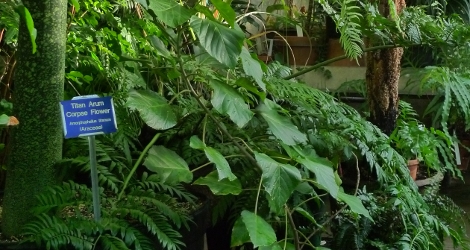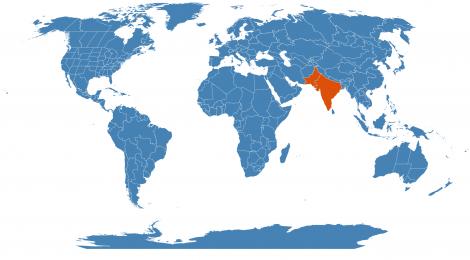Accession Data:
Corchorus olitorius L.
- Common Name: Nalta Jute, Tossa Jute
- Family: Malvaceae Juss.
- Description: Annual, much-branched herb 90-120 cm tall; stems glabrous. Leaves 6-10 cm long, 3.5-5 cm broad, elliptic-lanceolate, apically acute or acuminate, glabrous, serrate, the lower serratures on each side prolonged into a filiform appendage over 6 mm long, rounded at the base, 3-5 nerved; petioles 2-2.5 cm long, slightly pubescent, especially towards the apex; atipules subulate, 6-10 mm long. Flowers pale yellow; bracts lanceolate; peduncle shorter than the petiole; pedicles 1-3, very short. Sepals ca 3 mm long, oblong, apiculate. Petals 5 mm long, oblong spathulate. Style short; stigma microscopically papillose. Capsules 3-6.5 cm long, linear, cylindric erect, beaked, glabrous, 10-ribbed, 5-valved; valves with transverse partitions between the seeds. Seeds trigonous, black (Kirtikar and Basu, 1975).
- Uses: While perhaps better known as a fiber crop, jute is also a medicinal "vegetable", eaten from Tanganyika to Egypt. They are used in soups under the Arabic name "Molukhyia." In India the leaves and tender shoots are eaten. The dried material is there known as "nalita." Injections of olitoriside markedly improve cardiac insufficiencies and have no cumulative attributes; hence, it can serve as a substitute for strophanthin.
- Culture: Cut plants are tied into bundles, left to dry 2-4 days and shed their leaves. The jute is retted usually in stagnant water. After retting, the bundles are beat on the root end with a mallet to start the fibers which are wrapped around the fingers and the stems are jerked back and forth in the water to separate the fibers.
Summer annual; seeds should be saved at end of season and sown in spring.
Grown best during the rainy season in warm, humid climates Corchorus likes a warm, dry winter rest.
- USDA Zone: 10a-11
Accession Data:
- Accession # 200700053
- Source: Jardin Botanique De La Gacilly 2007 Index Seminum
- Accession Date: 03-19-2007
- Bench: 3116 - EVO: Propagation - Mist
- Currently: active - healthy
- Qty: 1 confirmed on 01-27-2022
Classification:
- Division: Magnoliophyta
- Class: Magnoliopsida
- SubClass: eurosid II
- Order: Malvales
- SubOrder:
- Family: Malvaceae
- SubFamily: Grewioideae
- Tribe: Sparrmannieae
- SubTribe:
Flowering Data:
This accession has been observed in bloom on:| Year | Jan | Feb | Mar | Apr | May | Jun | Jul | Aug | Sep | Oct | Nov | Dec | ||||||||||||||||||||||||||||||||||||||||
|---|---|---|---|---|---|---|---|---|---|---|---|---|---|---|---|---|---|---|---|---|---|---|---|---|---|---|---|---|---|---|---|---|---|---|---|---|---|---|---|---|---|---|---|---|---|---|---|---|---|---|---|---|
| 2022 | ||||||||||||||||||||||||||||||||||||||||||||||||||||
| 2021 | ||||||||||||||||||||||||||||||||||||||||||||||||||||
| 2020 | ||||||||||||||||||||||||||||||||||||||||||||||||||||
| 2019 | ||||||||||||||||||||||||||||||||||||||||||||||||||||
| 2018 | ||||||||||||||||||||||||||||||||||||||||||||||||||||
| 2017 | ||||||||||||||||||||||||||||||||||||||||||||||||||||
| 2016 | ||||||||||||||||||||||||||||||||||||||||||||||||||||
| 2015 | ||||||||||||||||||||||||||||||||||||||||||||||||||||
| 2014 | ||||||||||||||||||||||||||||||||||||||||||||||||||||
| 2013 | ||||||||||||||||||||||||||||||||||||||||||||||||||||
| 2012 | ||||||||||||||||||||||||||||||||||||||||||||||||||||
| 2011 | ||||||||||||||||||||||||||||||||||||||||||||||||||||
| 2010 | ||||||||||||||||||||||||||||||||||||||||||||||||||||
| 2009 | ||||||||||||||||||||||||||||||||||||||||||||||||||||
| 2008 | ||||||||||||||||||||||||||||||||||||||||||||||||||||
References (internal):
References (external):
- James A. Duke. 1983. Handbook of Energy Crops. unpublished. Adapted from New Crops Website at Purdue - last visited 04/19/02
- The Plant List (2013). Version 1.1. Last accessed on Friday, April 27, 2018.
- Jute at Wikipedia. Last accessed on Thursday, August 04, 2016.
- Corchorus olitorius at ARS-GRIN. Last accessed on Friday, April 27, 2018.
data regenerated on Wed, 07 Sep 2022 14:35:22 -0400 [bcm v4.0]
Images:

Additional images for this accession:
Click on thumbnails to enlargeCurrent Accessions in the Malvaceae
Subfamily Bombacoideae
Tribe Adansonieae
- Adansonia grandidieri

- Adansonia za

- Ceiba acuminata

- Ceiba pentandra


- Ceiba speciosa

- Pachira aquatica


- Pachira aquatica

- Pachira glabra

- Pseudobombax ellipticum

Subfamily Byttneroideae
Tribe Hermannieae
Subfamily Byttneroideae
Tribe Theobromeae
Subfamily Dombeyoideae
Tribe Dombeyeae
Subfamily Grewioideae
Tribe Grewieae
Subfamily Grewioideae
Tribe Sparrmannieae
Subfamily Malvoideae
Tribe Gossypieae
Subfamily Malvoideae
Tribe Hibisceae
- Hibiscus acetosella 'Haight Ashbury'

- Hibiscus rosa-sinensis cv. (yellow)

- Hibiscus tilliaceus

- Lagunaria patersonia

- Pavonia strictiflora



Subfamily Malvoideae
Tribe Malveae
Subfamily Sterculioideae
Tribe Sterculieae
W/C = Wild Collected
 = indicates flowering in past 14 days
= indicates flowering in past 14 days
 = images available for this accession
= images available for this accession
 = map available for this accession
= map available for this accession
 = accession added within past 90 days
= accession added within past 90 days
